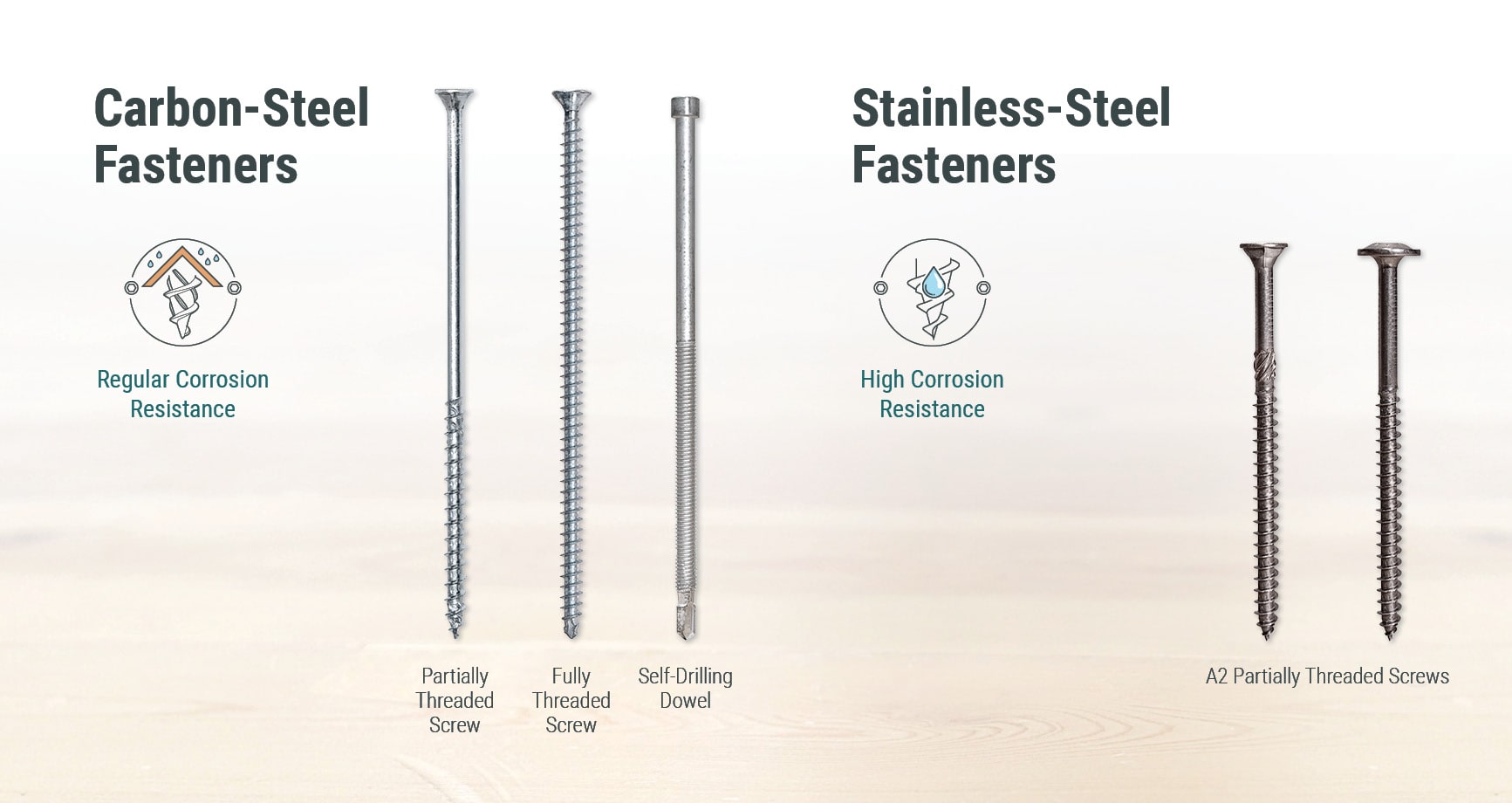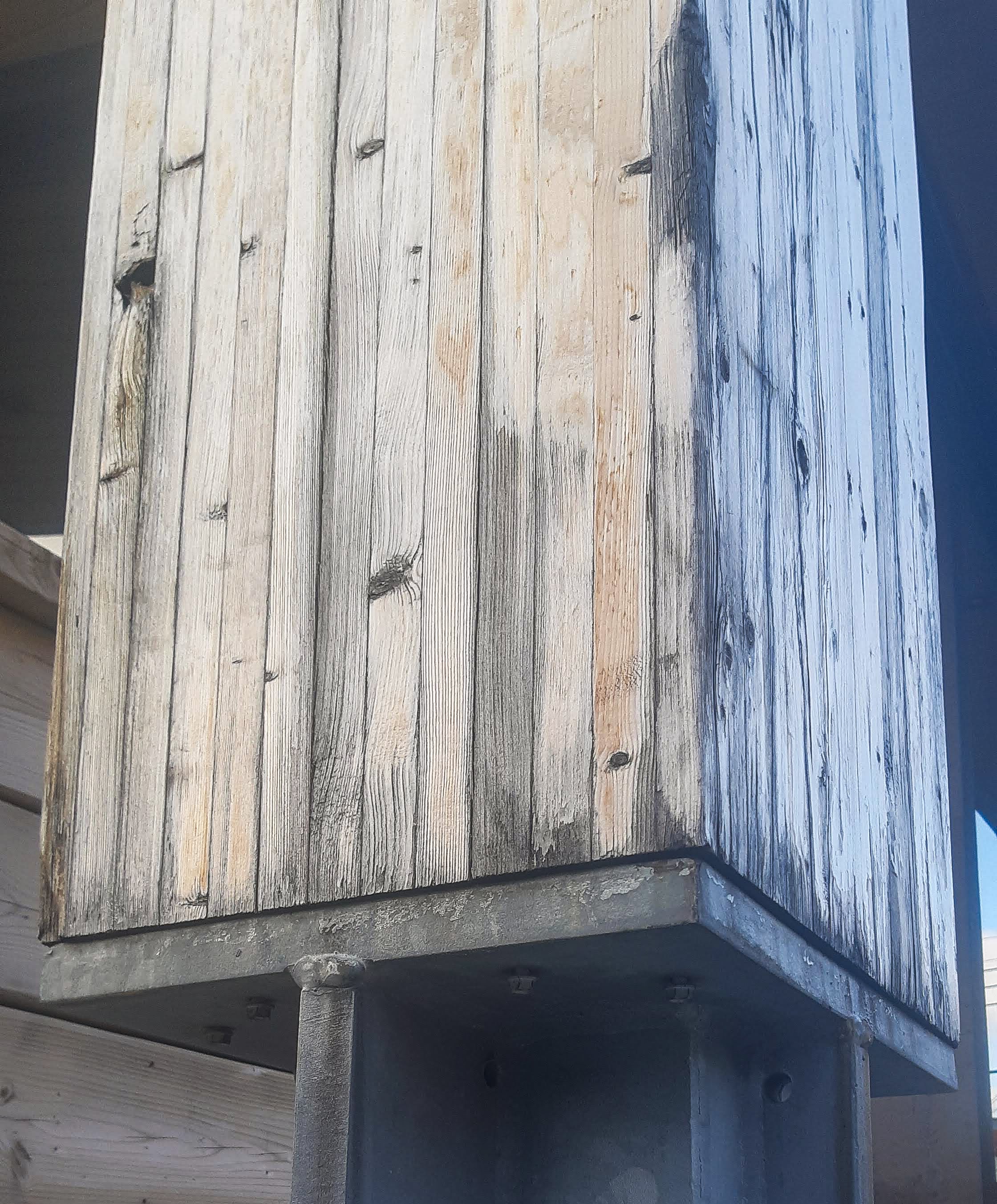MTC Solutions offers fasteners in both carbon steel (coated with zinc) and stainless steel to meet the exposure requirements of the North American timber construction industry. This article explores the two main types of exposure conditions—dry and wet—that timber structures may encounter during their service life. In addition, it provides general guidance for selecting screws based on anticipated service conditions.
Approximately a 7-minute read

Figure 1. Examples of fasteners offered by MTC Solutions.
Dry Service Conditions
Connections may be generally considered exposed to dry service conditions if the average equilibrium moisture content (MC) of the wood material remains below 15% on average, never exceeding 19% at any given time over the span of a year, according to Clause 11.3.3 of the National Design Specification for Wood Construction (NDS). MTC Solutions supplies two types of fasteners made of heat-treated carbon steel for use in designs intended for dry service conditions:
Coated with a thin protective layer of blue passivated zinc to resist minor corrosion during construction, these fasteners are intended for use in low-corrosive environments, such as untreated wood members and dry service conditions.
Establishing a connection with MTC Solutions SDDs in combination with a knife plate requires consideration of both the configuration of the connection and the potential swelling or shrinkage effect of moisture content variation. SDDs should be installed in dry timber, and the connection should be maintained at a constant moisture content to prevent the wood from swelling or shrinkage that can lead to the development of restraining stresses. More information on SDDs and knife plates, as well as guidance on avoiding restraining stresses, can be found in our Designing Internal Knife Plate blog post.
Wet Service Conditions
Connections may be considered in wet service conditions if the moisture content requirements for dry service conditions are not met. Wet service conditions include direct exposure to the elements, but even sheltered outdoor applications must be designed with care for the details as corrosion issues may arise due to wind-driven rain, splashing, and poor air circulation. Connections that do not meet the criteria for dry service conditions should be designed with fasteners with a higher class of corrosion resistance, such as MTC Solutions A2 stainless-steel STSs, available in two models:
The A2 designation is a stainless-steel grade used in Europe and corresponds to the Type 304 grade in North America. Stainless steel of this grade delivers good corrosion resistance, primarily attributed to its chromium and nickel components.
HDG is a process commonly employed to coat steel products with a protective layer of zinc, imparting them with corrosion resistance. This technique typically involves immersing the steel in a bath of molten zinc at an elevated temperature. The obtained zinc coating protects the steel from corrosion through two primary mechanisms.
First, zinc reacts with oxygen and carbon dioxide in the atmosphere, forming zinc carbonate that acts as a physical protective barrier against corrosive agents in the environment. Second, if the protective zinc layer is breached, zinc sacrificially corrodes to continue to protect the steel substrate. This process, known as galvanic corrosion, involves two metals dissimilar in electrochemical potential that are electrically connected and exposed to an electrolyte (e.g., moisture), with one (anode) undergoing preferential corrosion over the other (cathode). In the case of HDG, zinc assumes the role of the sacrificial anode due to its higher electrode potential (–0.76 V) than that of steel (or rather iron, –0.44 V). This attribute of zinc results in a greater tendency to lose electrons and undergo corrosive oxidation, thereby providing cathodic protection to the steel substrate.
Typically ranging from 75 to 200 microns in thickness, galvanized coatings offer many advantages, including high corrosion resistance, longevity, durability, and uniform coverage. These qualities position them as an excellent option for improving corrosion performance in metal components used in mass timber structures, particularly steel plates.
However, applying HDG to STSs poses challenges. Introducing an additional layer to the screw surface can compromise thread precision, impacting both sharpness and pitch. The resulting larger surface area also increases friction, necessitating higher torque levels and introducing complexities in the selection of suitable drill bits. Moreover, given that HDG involves a heat treatment, subjecting STSs to this process after they have been case-hardened at elevated temperatures may lead to annealing. This thermal effect can alter crucial mechanical properties, including tensile, withdrawal, and torsional strength, further complicating the installation process.
Detailing Considerations Relative to Service Conditions
To help designers navigate the detailing process considering anticipated service conditions, MTC Solutions recommends the following ten guidelines:

Figure 2. Residual visual evidence of a column exposed to wet service conditions.
The service environment is a crucial factor to be considered in the detailing process as it can significantly impact connection performance. For more information and design guidance, please contact our Technical Support Team. 🙂
Register for a Technical Learning Session
Sign up for MTC Newsletter and keep up to date with all our progress.